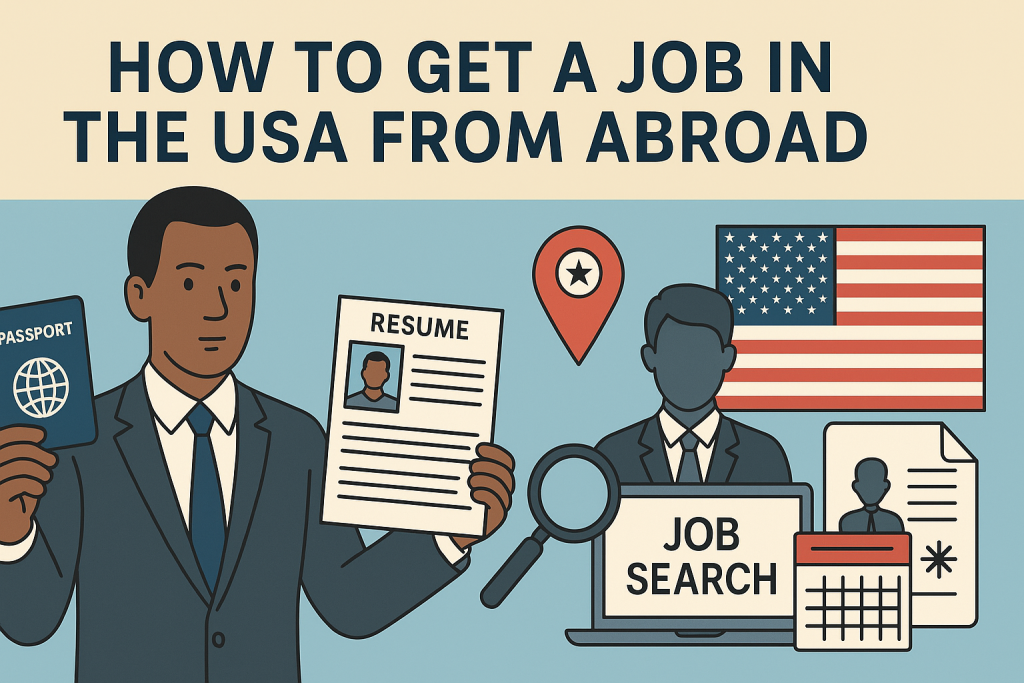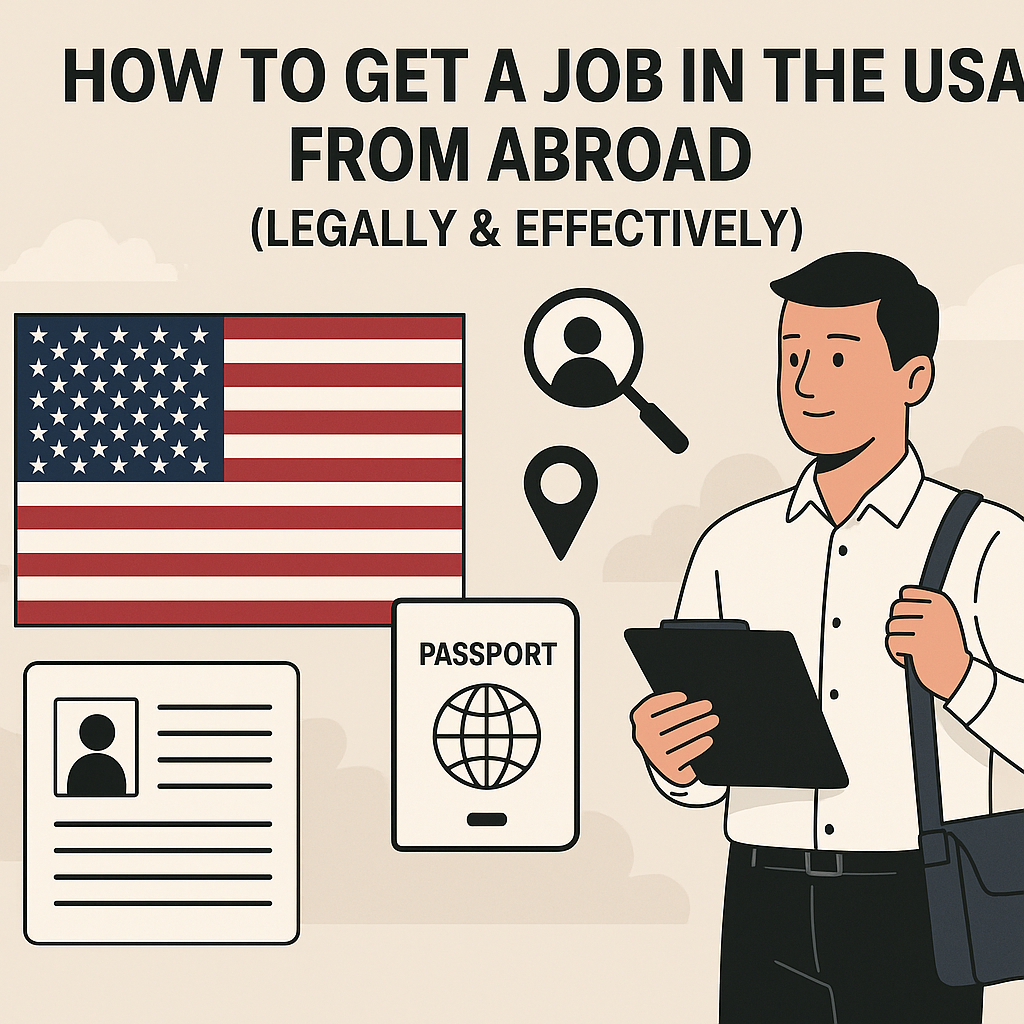Introduction
The United States remains one of the most attractive destinations for international job seekers due to its economic stability, career opportunities, and cultural diversity. However, securing a job in the USA from abroad requires a combination of legal procedures, professional strategies, and careful planning. This comprehensive guide walks you through every step of the process, including legal visa options, resume preparation, job portals, interview tips, and settlement advice.
1. Understanding the Legal Framework
A. Work Visas: Your Gateway to Employment
To work legally in the U.S., you need a valid work visa. Here are the most common ones:
- H-1B Visa (Specialty Occupations): For jobs that require a bachelor’s degree or higher, mainly in fields like IT, engineering, finance, and healthcare.
- L-1 Visa (Intra-Company Transfer): If you’re working in a multinational company with branches in the U.S., this is an option.
- O-1 Visa (Extraordinary Ability): For individuals with exceptional talent in sciences, arts, education, or sports.
- TN Visa: For citizens of Canada and Mexico under the USMCA agreement.
- Green Card via Employment: Though more permanent, this is a longer and competitive process.
B. Sponsorship: What It Means and How to Secure It
Most work visas require employer sponsorship. This means:
- The employer files a petition with USCIS on your behalf.
- They may pay associated fees and prove no suitable American worker is available (for some visas).
Pro Tip: Target companies known for sponsoring international candidates. Check the H1B Sponsor Database or sites like myvisajobs.com.
2. Preparing an American-Style Resume and Cover Letter
A. Resume Formatting
- Keep it 1–2 pages long
- Use clear sections: Summary, Skills, Experience, Education
- Focus on achievements, not just responsibilities
- Avoid photos, age, marital status, or nationality
B. Tailoring Your Resume
- Use keywords from the job posting
- Highlight quantifiable results (e.g., “Increased sales by 30%”)
- Show your international experience as an asset
C. Cover Letter Best Practices
- Keep it concise (3–4 paragraphs)
- Mention your visa status or sponsorship needs honestly
- Express enthusiasm and why you’re a good fit

3. Where to Find US Job Opportunities
A. Top Job Portals
- LinkedIn – Best for networking and applications
- Indeed – Widest reach for various industries
- Glassdoor – Job reviews and company insights
- AngelList – Great for startups
- USAJobs.gov – Government and federal roles
B. Niche Websites
- Tech jobs: Dice, Stack Overflow Jobs
- Healthcare: Health eCareers, PracticeLink
- Academia: HigherEdJobs, ChronicleVitae
C. Staffing & Recruitment Agencies
Some U.S.-based recruiters specialize in placing international talent:
- Robert Half
- Michael Page
- TEKsystems (for tech roles)
4. Networking from Abroad
A. Using LinkedIn Effectively
- Optimize your profile with U.S. job market keywords
- Connect with HR professionals in your target companies
- Engage in relevant posts and groups
B. Alumni Networks
- Reach out to alumni from your university who are working in the U.S.
- Use platforms like LinkedIn Alumni or university career services
C. Online Events & Webinars
- Attend virtual career fairs
- Participate in webinars hosted by U.S. companies
5. Applying for Jobs: Best Practices
A. Understand the Job Description
- Identify required qualifications and preferred experience
- Match your skills accordingly
B. Customize Every Application
- Avoid sending generic resumes
- Tailor each resume and cover letter to the specific job
C. Be Honest About Your Visa Status
- Employers appreciate transparency
- Don’t wait till the final stage to mention sponsorship needs
6. Interviewing with US Employers
A. Cultural Tips
- Be direct, but polite
- Show enthusiasm and team orientation
- Prepare to discuss your achievements clearly
B. Common Interview Formats
- Phone interviews
- Video interviews (Zoom, Google Meet)
- Technical assessments (especially in IT)
- Behavioral interviews (STAR method)
C. Questions to Expect
- “Why do you want to work in the US?”
- “Can you describe a time you solved a problem?”
- “What’s your visa situation?”
7. Legal Steps After Receiving a Job Offer
A. Employer Files Petition (I-129)
- For H-1B and similar visas
- Processing can take weeks to months
B. Attend Visa Interview at US Embassy
- Submit required documents
- Demonstrate intent to return (for non-immigrant visas)
C. Wait for Approval and Enter the U.S.
- You can enter up to 10 days before your job start date
- Keep copies of offer letter, visa approval, and I-797 with you
8. Settling in the U.S.: First Steps
- Get a Social Security Number (SSN)
- Open a bank account
- Find short-term housing initially (Airbnb, sublets)
- Apply for health insurance if not employer-covered
- Understand U.S. tax obligations
9. Alternatives to Employment-Based Entry
- Student Visa (F-1) + OPT + H-1B: Study first, then work
- J-1 Exchange Program: Internships and fellowships
- Family Sponsorship: If married to a U.S. citizen or PR
- Entrepreneur Route: Start your own business (E-2 or EB-5)
Conclusion
Landing a job in the United States from abroad is undoubtedly challenging, but thousands achieve it every year with the right strategy, preparation, and patience. From choosing the appropriate visa to preparing a U.S.-style resume and mastering cultural nuances in interviews, success depends on how well-informed and proactive you are.
Stay persistent, keep networking, and don’t hesitate to seek legal advice or career coaching if needed. With time and effort, your American dream can indeed become a reality.
Want help preparing your resume or finding job sponsors? Contact us at jobs.nighttteer.com/contact
